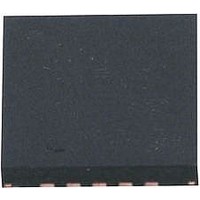LTC4160EUDC#PBF Linear Technology, LTC4160EUDC#PBF Datasheet - Page 24

LTC4160EUDC#PBF
Manufacturer Part Number
LTC4160EUDC#PBF
Description
IC, BATT CHRG, Li-Ion, Li-Polymer, 1.2A, QFN20
Manufacturer
Linear Technology
Datasheet
1.LTC4160EPDCPBF.pdf
(32 pages)
Specifications of LTC4160EUDC#PBF
Battery Type
Li-Ion, Li-Polymer
Input Voltage
5.5V
Battery Charge Voltage
4.2V
Charge Current Max
1.2A
Battery Ic Case Style
QFN
No. Of Pins
20
No. Of Series Cells
1
Rohs Compliant
Yes
Lead Free Status / RoHS Status
Lead free / RoHS Compliant
Available stocks
Company
Part Number
Manufacturer
Quantity
Price
LTC4160/LTC4160-1
APPLICATIONS INFORMATION
Therefore, the hot trip point is set when:
And the cold trip point is set when:
Solving these equations for R
in the following:
and
By setting R
in r
to the Vishay Resistance-Temperature Curve 1 chart gives
a hot trip point of about 40°C and a cold trip point of about
0°C. The difference between the hot and cold trip points
is approximately 40°C.
By using a bias resistor, R
R25, the hot and cold trip points can be moved in either
direction. The temperature span will change somewhat
due to the non-linear behavior of the thermistor. The fol-
lowing equations can be used to calculate a new value for
the bias resistor:
where r
sired hot and cold trip points. Note that these equations
are linked. Therefore, only one of the two trip points can
be chosen, the other is determined by the default ratios
designed in the IC. Consider an example where a 60°C
hot trip point is desired.
From the Vishay Curve 1 R-T characteristics, r
0.2488 at 60°C. Using the above equation, R
24
R
R
R
R
R
R
HOT
NTC|HOT
NTC|COLD
NOM
NOM
NOM
NOM
= 0.536 and r
R
R
HOT
NTCHOT
NTC COLD
=
=
+
+
R
R
r
0 536
and r
NOM
3 25
= 0.536 • R
COLD
r
NTCHOT
NTC COLD
.
HOT
= 3.25 • R
.
equal to R25, the above equations result
COLD
•
•
R
R
COLD
25
•
25
are the resistance ratios at the de-
•
NTCBIAS
NOM
NOM
NTCBIAS
= 3.25. Referencing these ratios
NOM
NTC|COLD
, different in value from
=
=
0 349
0 765
.
and R
.
•
NTC|HOT
NTCBIAS
•
NTCBIAS
NOM
results
should
HOT
is
be set to 46.4k. With this value of R
and the cold trip point is about 16°C. Notice that the span
is now 44°C rather than the previous 40°C. This is due to
the decrease in “temperature gain” of the thermistor as
absolute temperature increases.
The upper and lower temperature trip points can be inde-
pendently programmed by using an additional bias resistor,
R1, as shown in Figure 8. The following formulas can be
used to compute the values of R
For example, to set the trip points to 0°C and 45°C with
a Vishay Curve 1 thermistor choose:
the nearest 1% value is 105k:
the nearest 1% value is 12.7k. The final solution is shown
in Figure 8 and results in an upper trip point of 45°C and
a lower trip point of 0°C.
R1 = 0.536 • 105k – 0.4368 • 100k = 12.6k
R
R
R
NOM
1 0 536
NOM
NTCBIAS
T
R
100k
=
NOM
R
100k
NTC
NTC
=
.
=
r
3 266 0 4368
3
4
Figure 7. Standard NTC Configuration
COLD
.
2 714
•
0.349 • NTCBIAS
R
.
0.765 • NTCBIAS
2 714
NOM
–
.
– .
r
HOT
0.1V
–
r
•
HOT
LTC4160/LTC4160-1
R
25
NTC BLOCK
•
•
–
+
–
+
+
–
100
R R 25
NOM
k
=
NOM
and R1:
104 2
, r
.
TOO_COLD
TOO_HOT
NTC_ENABLE
COLD
k
is 1.436
41601 F07
41601fa













